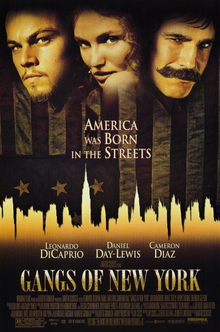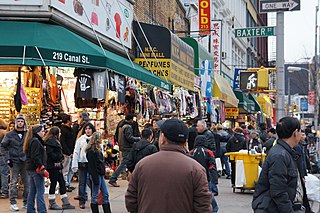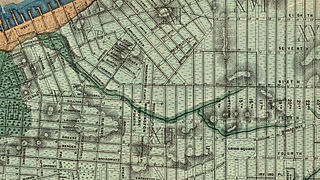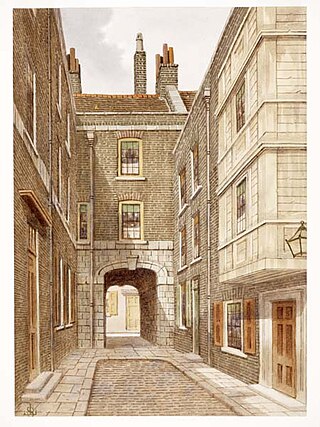
Five Points was a 19th-century neighborhood in Lower Manhattan, New York City. The neighborhood, partly built on low-lying land which had filled in the freshwater lake known as the Collect Pond, was generally defined as being bound by Centre Street to the west, the Bowery to the east, Canal Street to the north, and Park Row to the south. The Five Points gained international notoriety as a densely populated, disease-ridden, crime-infested slum which existed for over 70 years.

Gangs of New York is a 2002 American epic historical drama film directed by Martin Scorsese and written by Jay Cocks, Steven Zaillian, and Kenneth Lonergan, based on Herbert Asbury's 1927 book The Gangs of New York. The film stars Leonardo DiCaprio, Daniel Day-Lewis, and Cameron Diaz, along with Jim Broadbent, John C. Reilly, Henry Thomas, Stephen Graham, Eddie Marsan, Brendan Gleeson, and Liam Neeson in supporting roles. The film also marks the start of a fruitful collaboration between DiCaprio and Scorsese.

An apartment, flat, or unit is a self-contained housing unit that occupies part of a building, generally on a single story. There are many names for these overall buildings. The housing tenure of apartments also varies considerably, from large-scale public housing, to owner occupancy within what is legally a condominium or leasehold, to tenants renting from a private landlord.

Collect Pond, or Fresh Water Pond, was a body of fresh water in what is now Chinatown in Lower Manhattan, New York City. For the first two centuries of European settlement in Manhattan, it was the main New York City water supply system for the growing city. A jail was later built on the former pond. In the 20th century, the site became Collect Pond Park, which includes a reflecting pool to acknowledge the historic importance of this body of water.

Canal Street is a major east–west street of over 1 mile (1.6 km) in Lower Manhattan, New York City, United States, running from East Broadway between Essex and Jefferson Streets in the east, to West Street between Watts and Spring Streets in the west. It runs through the neighborhood of Chinatown, and forms the southern boundaries of SoHo and Little Italy as well as the northern boundary of Tribeca. The street acts as a major connector between Jersey City, New Jersey, via the Holland Tunnel (I-78), and Brooklyn in New York City via the Manhattan Bridge. It is a two-way street for most of its length, with two unidirectional stretches between Forsyth Street and the Manhattan Bridge.

A tenement is a type of building shared by multiple dwellings, typically with flats or apartments on each floor and with shared entrance stairway access. They are common on the British Isles, particularly in Scotland. In the medieval Old Town, in Edinburgh, tenements were developed with each apartment treated as a separate house, built on top of each other. Over hundreds of years, custom grew to become law concerning maintenance and repairs, as first formally discussed in Stair's 1681 writings on Scots property law. In Scotland, these are now governed by the Tenements Act, which replaced the old Law of the Tenement and created a new system of common ownership and procedures concerning repairs and maintenance of tenements. Tenements with one- or two-room flats provided popular rented accommodation for workers, but in some inner-city areas, overcrowding and maintenance problems led to shanty towns, which have been cleared and redeveloped. In more affluent areas, tenement flats form spacious privately owned houses, some with up to six bedrooms, which continue to be desirable properties.

Mulberry Street is a principal thoroughfare in Lower Manhattan, New York City, United States. It is historically associated with Italian-American culture and history, and in the late 19th and early 20th centuries was the heart of Manhattan's Little Italy.
The history of New York City (1784–1854) started with the creation of the city as the capital of the United States under the Congress of the Confederation from January 11, 1785, to Autumn 1788, and then under the United States Constitution from its ratification in 1789 until moving to Philadelphia in 1790. The city grew as an economic center with the opening of the Erie Canal in 1825; the growth of its railroads added to its dominance. Tammany Hall began to grow in influence with the support of many Irish immigrants, culminating in the election of the first Tammany mayor, Fernando Wood, in 1854. The city had become the nation's most important port and financial center and competed with Boston as the center of high culture.

Centre Street is a north–south street in the New York City borough of Manhattan, running through the Civic Center, Chinatown, and Little Italy neighborhoods of Lower Manhattan. It connects Park Row to the south with Cleveland Place to the north. Centre Street carries northbound traffic north of Reade Street and two-way traffic between Reade Street and the Brooklyn Bridge.

Doyers Street is a 200-foot-long (61 m) street in the Chinatown neighborhood of Manhattan in New York City. It is one block long with a sharp bend in the middle. The street runs south and then southeast from Pell Street to the intersection of Bowery, Chatham Square, and Division Street. Doyers Street contains several restaurants, barber shops, and hair stylists, as well as the Chinatown branch of the United States Postal Service. The Nom Wah Tea Parlor opened at 13 Doyers Street in 1920, and is still in operation; other longstanding business include Ting's Gift Shop at 18 Doyers which opened in 1957.
The Baxter Street Dudes was a New York City teenage street gang, consisting of former newsboys and bootblacks, who ran the Grand Duke's Theatre from the basement of a dive bar on Baxter Street in Manhattan during the 1870s. Led by founder Baby-Face Willie, gang members operated the Grand Duke's Theatre and established the venue as their headquarters. Members of the Baxter Street Dudes wrote and performed plays, musicals and variety shows which were enjoyed by other street toughs and slummers throughout the city. The theater house eventually became a popular underworld hangout, from which the gang found financial success.

The Dead Rabbits riot was a two-day civil disturbance in New York City evolving from what was originally a small-scale street fight between members of the Dead Rabbits and the Bowery Boys into a citywide gang war, which occurred July 4–5, 1857. Taking advantage of the disorganized state of the city's police force—brought about by the conflict between the Municipal and Metropolitan police—the fighting spiraled into widespread looting and damage of property by gangsters and other criminals from all parts of the city. It is estimated that between 800 and 1,000 gang members took part in the riots, along with several hundred others who used the disturbance to loot the Bowery area. It was the largest disturbance since the Astor Place Riot in 1849 and the biggest scene of gang violence until the New York Draft Riots of 1863. Order was restored by the New York State Militia, supported by detachments of city police, under Major-General Charles W. Sandford.

Jack Mahaney was an American criminal, sneak thief, confidence man and gang leader in New York City during the late-19th century. He was also one of the most notorious prisoner escapees of his time, popularly referred to as the "American Jack Sheppard", successfully escaping from virtually every major prison in the eastern United States including The Tombs and Sing Sing. Mahaney also escaped from custody which included well-publicized incidents where he jumped from a train without injury.
Reverend Louis or Lewis Morris Pease was an American Methodist clergyman, educator and prominent reformer during the mid-to late 19th century. He founded the Five Points Mission and later the Five Points House of Industry, established in New York City's infamous Five Points district, which provided religious teaching and work for the area's predominantly working-class Irish Catholics.
Thomas Hadden was American saloon keeper, criminal and underworld figure in New York City's infamous Fourth Ward during the mid-to late 19th century. He was the owner of a Cherry Street dive bar, a popular underworld hangout located next to Dan Kerrigan's place, and co-led the Dead Rabbits with Kit Burns. For over 25 years, his Water Street boarding house was one of the most notorious "crimp houses" on the New York waterfront as thousands of sailors were shanghaied, robbed or murdered. Hadden, and contemporaries such as Bill Slocum or John Allen, exercised considerable political influence in the city and were generally able to receive protection from city officials throughout their criminal careers.

Mulberry Bend was an area surrounding a curve on Mulberry Street, in the Five Points neighborhood in Lower Manhattan, New York City. It is located in what is now Chinatown in Manhattan.

Minetta Creek was one of the largest natural watercourses in Manhattan, New York City, United States. Minetta Creek was fed from two tributaries, one originating at Fifth Avenue and 21st Street, and the other originating at Sixth Avenue and 16th Street. They joined near Fifth Avenue and 11th Street then took a southwesterly course. Minetta Creek's name is thought to have originated from either the Native American term "Manette", meaning "Devil's Water", or the Dutch word "Minnetje", meaning "the little one".

Baxter Street is a narrow thoroughfare that runs in a north–south direction in the borough of Manhattan in New York City, United States. It lies between Mulberry Street and Centre Street. It runs through Little Italy and the edge of Chinatown. Today, it runs one-way southbound from Grand Street to Hogan Place, and one-way northbound for its southernmost block from Worth Street to Hogan Place.

Columbus Park formerly known as Mulberry Bend Park, Five Points Park and Paradise Park, is a public park in Chinatown, Manhattan, in New York City that was built in 1897.

Hanging Sword Alley is an alley in the Alsatia district of London, running between Whitefriars Street and Salisbury Square, close to Fleet Street.
















